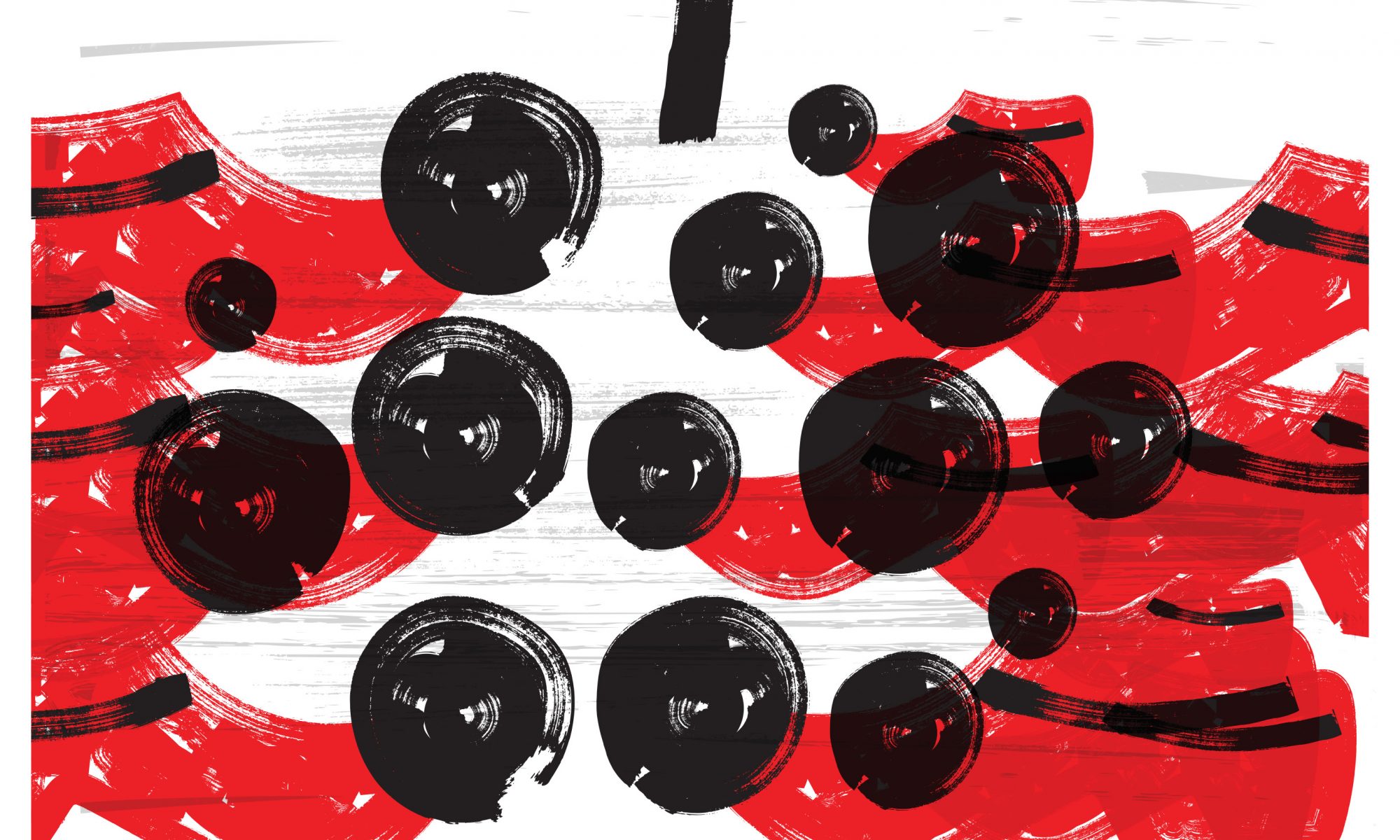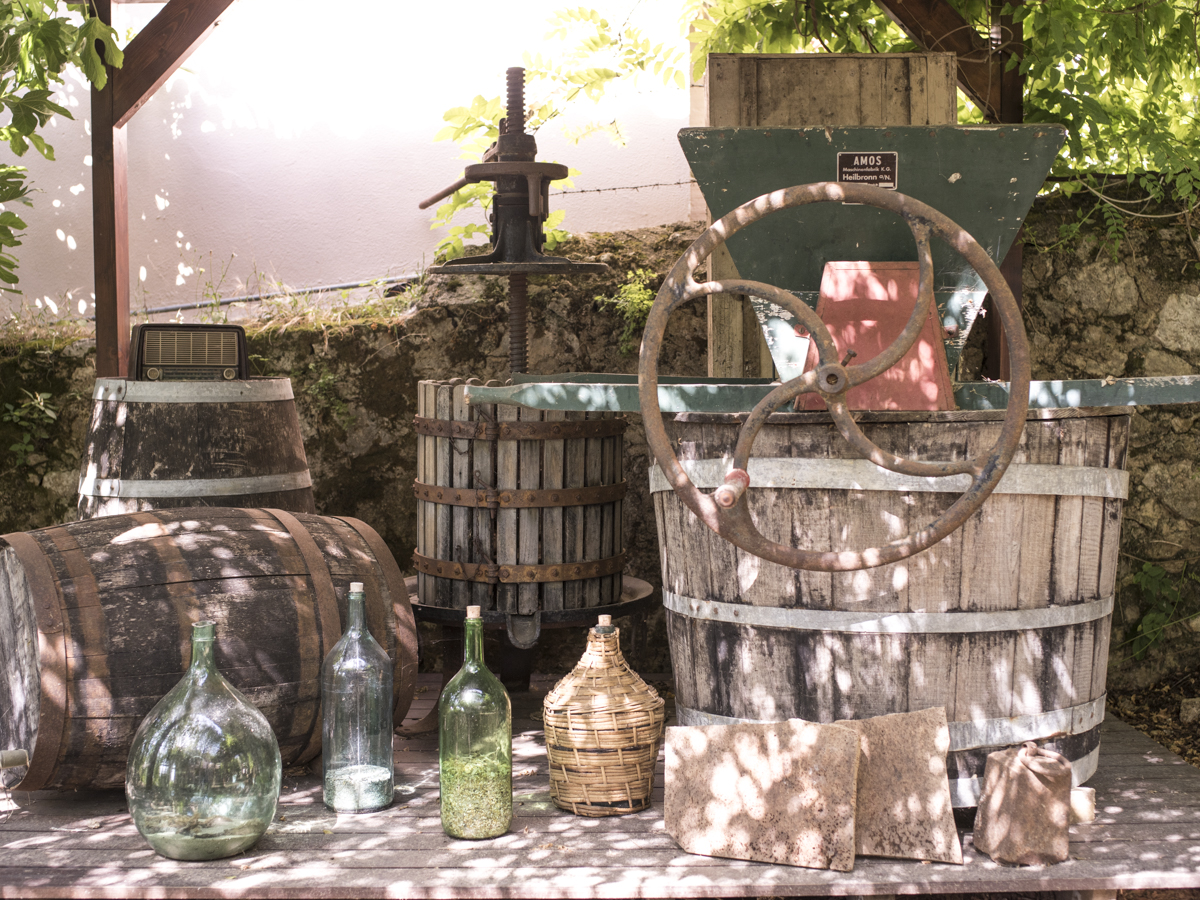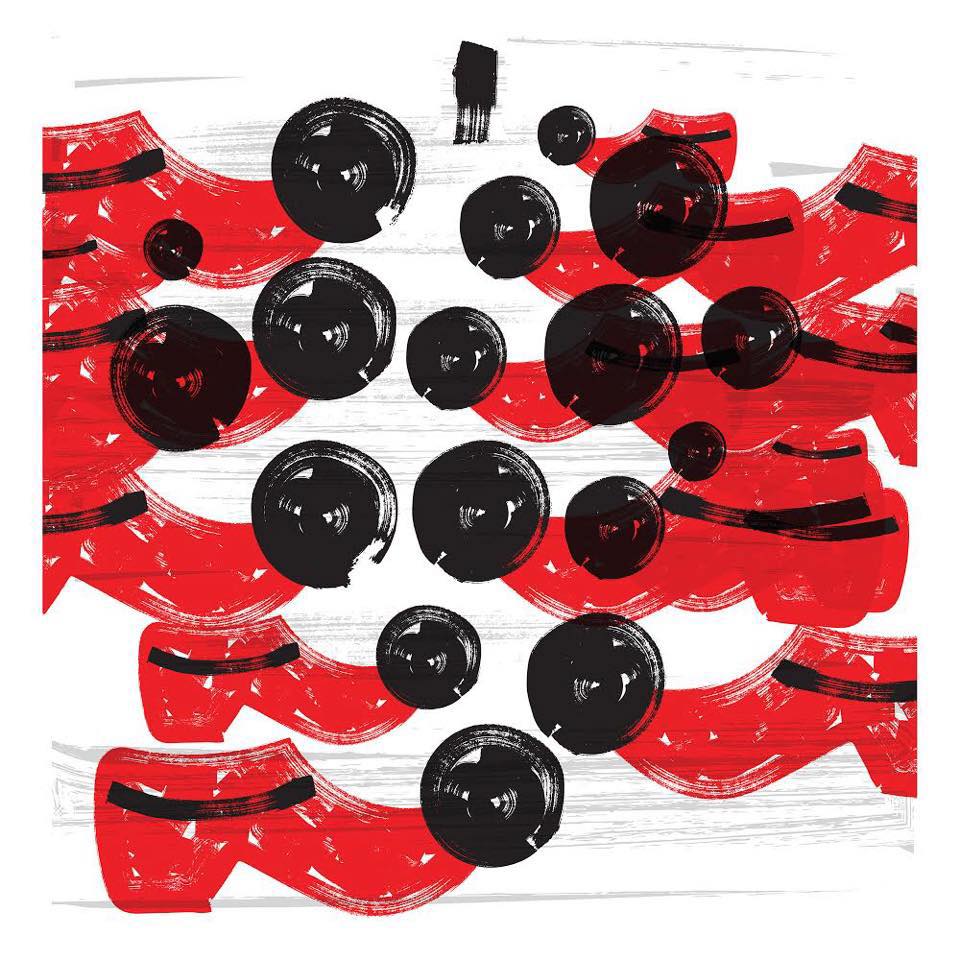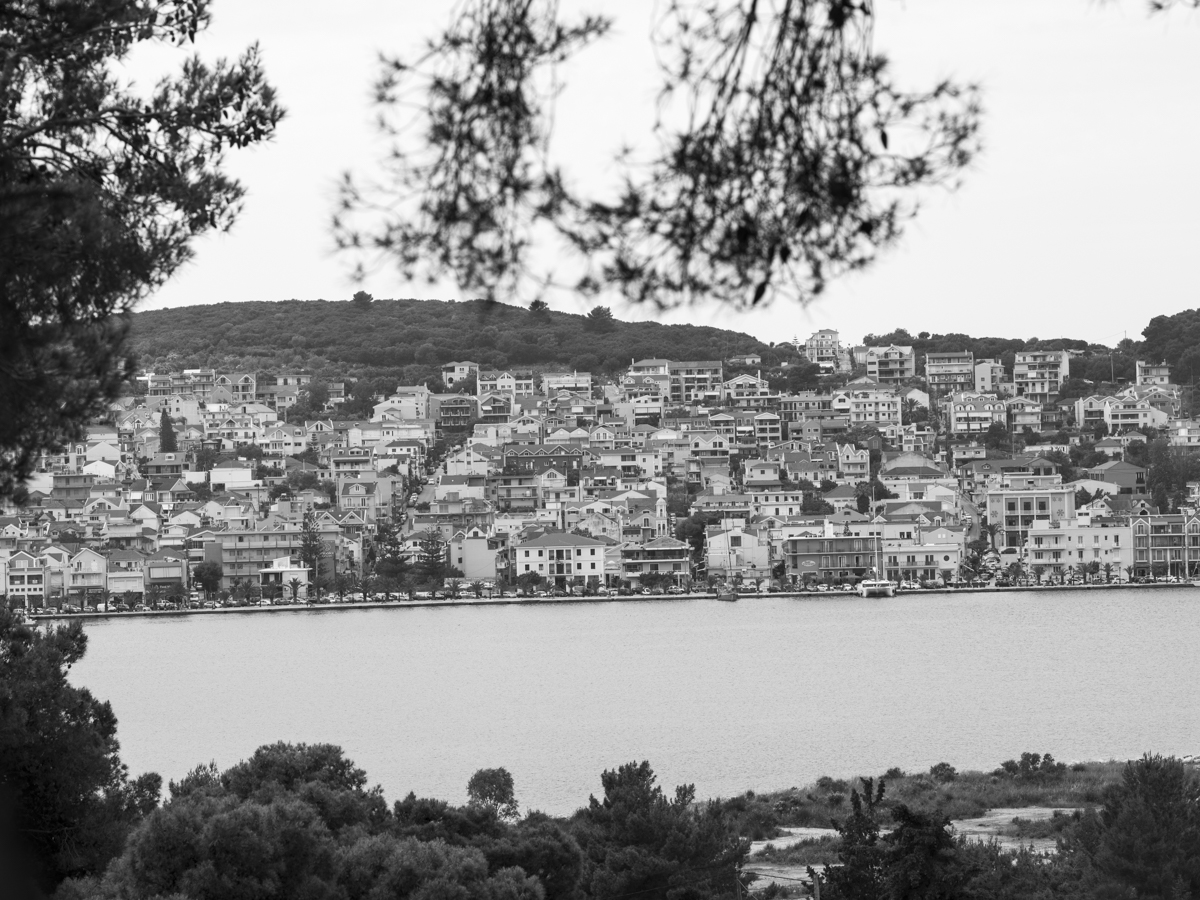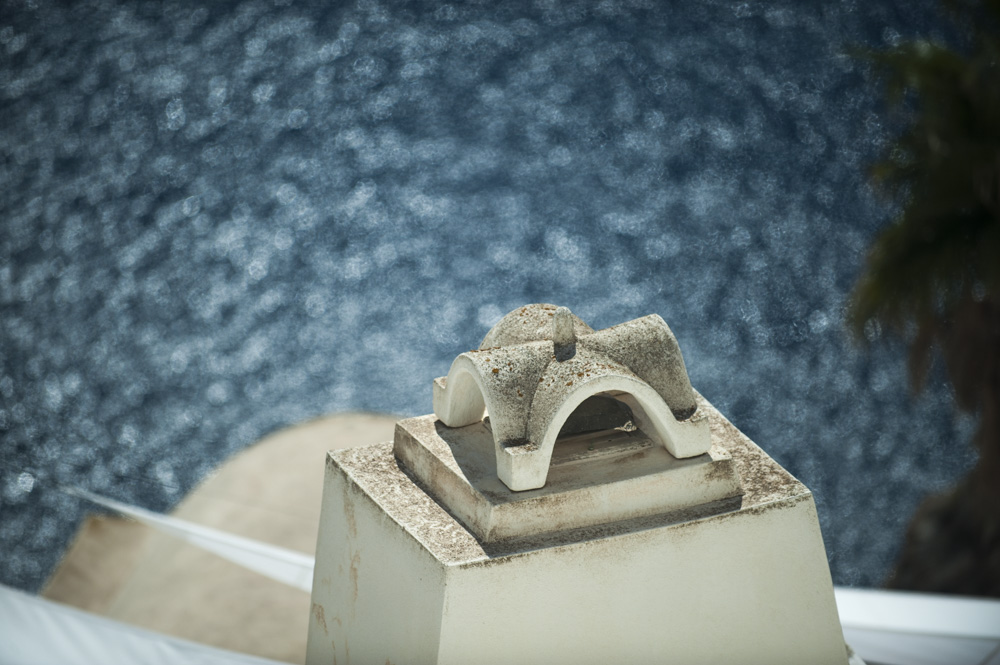Island and Terroir | text by Κonstantinos Lazarakis, MW | issue 10

Talk to zoologists about islands and they will tell you that
these parts of the world are special places with special
species. Animals that are found in large numbers in a
number of locations often share characteristics. However, in isolated spots such as islands, you’ll find specimens
that are very different from members of the same species
elsewhere. There are, for instance, islands with tiny elephants or with huge lizards. Even birds, the least secluded subjects of the animal kingdom, can evolve along unusual lines on an island. This is even more evident in plants. The pathways these forms of life follow in isolation cause them to deviate from the overall norm in wholly unexpected directions.
For people that study wine, this is no surprise. They call it “terroir”. It’s a French word, now universally used, to denote the infinite number of factors, usually associated with the environment, that make the wine made from grapes grown in Spot A different from wine made from grapes grown in Spot B. It’s the weather, the climate, the soil, the position relative to the sun, the slope of the land, the way the vine is trained and, indeed, any other factor you might want to include. By definition, terroir is so complex, chaotic and, to a certain degree, incomprehensible, that it will never be fully understood; two terroirs will never be identical. This is true for wines; now imagine it happening for millennia, and to large populations of animals or plants.
In fact, it’s true for humans as well. Homo Sapiens is subject to terroir as well. Anthropologists will confirm that inhabitants of islands can be very, very interesting, perhaps more so than mainlanders. There are reasons for this; a relatively isolated community will allow singularities of character, of religion and of customs to circulate, become standard and endure. Unusual behavior (or ideas) that would have been eradicated in a matter of years in other landscapes becomes part of the dominant culture.
Nevertheless this isolation is not complete, even if you are in the remote Solomon Islands. The environment, the terroir, promotes specific human characteristics that are of prime importance to survival. Acute observance, atten- tion to detail, informed risk-taking all provide enormous competitive advantages. There is a need to see what is beyond the sea – but there are dangers as well, potential or actual, related to what might go out and what might come in.Experts agree that the Greek islands are outstanding in a number of ways. The islands in the Aegean and the Ionian islands in the Adriatic share common characteristics found only in a few parts of our world, one of which is the Sea of Japan. As in Greece, the Japanese islands are isolated and yet near to one other. With their Greek coun- terparts, they share rough seas and a rich history, but it is the breathtaking natural beauty of the islands that is their greatest common trait.
Then we have the vines − and the wines − of the amazing Greek islands. For centuries, people have been trying B to cope with too much sun, too much wind, volcanoes and arid soil, all while trying to grow vines and make tasty wines. Only the toughest, most interesting varieties would be fit for purpose.
The Greek islands are the apogee of viticultural natural selection, with numerous autochthonous grapes that can be found nowhere else. The character of these unique wines is amazing. The aggressiveness of the ter- roir shows through in the wines, but in a truly positive way. The island wines reflect the island culture; the food, the approach to enjoying life, and the love that the island-ers have for the mesmerising splendor of their homeland. The wines of Greek islands are the amazing result of the symbiotic relationship between a symbiotic relationship between a demanding yet beautiful landscape, an amazing plant and some islanders struggling to understand and enjoy life. But then in a way, we’re really all islanders, aren’t we?
Greek wine today | text by Yiannis Kaimenakis, Wine Sommelier | issue 10

These days, we are able to enjoy some very fine Greek wines, something that would have seemed like a pipe dream in the not-so-distant decade of the 1980s. In the recent past to which I’m referring, choices were particularly limited and the quality of wines was rather poor. Today, however, Nemea, Naoussa, Mantinia, Santorini, Crete and all the other place names associated with Greek wine generously offer us the fine fruit of their soil. We drink them gladly for various reasons, but the million dollar question remains: how well can Greek wine do internationally, or, put another way, how appealing does our wine look on the racks of a wine shop abroad, nestled in among a variety of choices from France, Italy, Spain and the New World countries?
We Greeks may drink Greek wine intuitively, just as we listen to Greek music or watch Greek films, perhaps either for reasons of localisation or out of sheer habit. I think that the greatest challenge we face is rendering our products competitive on an international level. Outside the borders of Greece, the drums of chauvinism don’t beat. Words like meraki (the love, care and often personal touch one puts into his work or to a given activity) or filtimo (one’s responsibility to oneself to act in accordance with righteousness, honor and dignity), and all other such nonsense we use as alibis are no longer valid; things are stripped down to their essence.
Looking back on our country’s wine history, I will admit that the purely oenological sector, the segment in charge of production, did its job with consistency and professionalism. Certain early slips, such as the overproduction of wines from foreign varieties, like Sauvignon Blanc, Merlot and Cabernet Sauvignon, at the beginning of the period of rebirth that Greek wineries underwent, were inevitable mistakes: back in the 1980s, we ourselves we let alone our potential foreign buyers. In the “era of the terroir” in which we are living today, this “indigenous” issue has been resolved, and grapes such as Agiorgitiko, Xinomavro, Assyrtiko and Moschofilero now play a key role in the industry.
I have to say that I disagree to a certain extent with the commercial orientation of our wines, something for which, of course, the winemakers themselves aren’t responsible. Instead of focusing on place names, we’ve currently made brand names pivotal. This choice creates trends and boosts easy sales inside the borders of Greece but, at the same time, it makes it harder for winemaking regions to acquire more universal recognition.
Despite the progress made in recent years, our wine identity is still not entirely clear. In my opinion, the first obstacle we face is our multiformity. New Zealand, for example, planted Sauvignon Blanc vines for the first time in 1972. Very quickly, it managed to establish itself on the international market because it had a single grape, a single style and a single wine color to promote. In our case, it’s anything but easy to create an identity encompassing such a wide range of varieties, including Malagousia, Vidiano, Mandilaria and Robola.
Another, more fundamental, aspect is that of the price range. For some reason, despite the fact that all wine-growing zones generally provide different wines corresponding to everyday life on the one hand and to Sunday meals and special occasions on the other − with corresponding price ranges − we still insist on producing truly great wines that are destined exclusively for the “upper shelf”. Luckily, the financial crisis has had a significant impact on winemaking, pointing it in a more budget-friendly direction. In a country with a strong culinary tradition like Greece, it would be a mistake not to coordinate wine and food growth rates. Both here in Greece and abroad, we have some great restaurants that promote their Greek origins and identity in a laudable manner. Greek food is, beyond a doubt, the ideal “vehicle” to assist Greek wine on its journey to greater recognition. A few years ago, we had every reason to complain, as the quality, the aesthetics and the general standards of Greek restaurants abroad were an insult to us all. Today, things have improved dramatically and you can find modern and creatively competitive representatives of Greek gastronomy in all of the large cities around the world.
It’s my belief that Greek wine has already reintroduced itself to consumers outside the borders of Greece. Of paramount importance is the fact that we’ve managed to shake off the bad reputation that had, not without reason, dogged our wines in the past. Establishing oneself is something that takes time, devotion and hard work. I would suggest we put aside the obsessive love for our country that blinds our judgment, and let consistency and patience guide us instead. ●
Cephalonia | text by Thalia Kartali & Penelope Katsatou | Photography by Giorgos Kaplanidis, issue 10
According to Greek mythology, the island of Cephalonia (kefalonia in Greek) owes its name to Kefalos, who defeated the Televoes and became the island’s first inhabitant. It is said that kefalos planted a grapevine from mainland Greece, from where he originally came, and this is how the island’s long history in winemaking began
During Venetian rule, the wine produced on Cephalonia was exported on a regular basis to Europe. A series of earthquakes which hit the island in 1953 caused major destruction and many deaths; many of its inhabitants were forced to leave the island and start a new life elsewhere. Many emigrated to the United States and Australia. Today, Cephalonia has 3 PDO level appellations and is considered one of the most promising winemaking areas in Greece, producing some very interesting wines from indigenous varieties, the most famous of which is Robola, a white variety which produces a dry white wine with high acidity and a mineral character. Most of the island’s vineyards are in the mountainous areas of the central and southern part of the island. Thanks to the efforts of a dynamic group of winemakers, Cephalonia has the potential to become a great wine tourism destination (it is, in any case, already well-known as a vacation spot for general tourism), granting its visitors the opportunity to taste wines from indigenous varieties found only here. Grape visited five of the six main producers on the island and discovered − apart from beautiful landscapes − different approaches to winemaking, ranging from biodynamic winemaking following a more traditional approach to more technologically innovative modern methods; all of the wineries, however, revealed the amazing potential of these unique indigenous varieties.
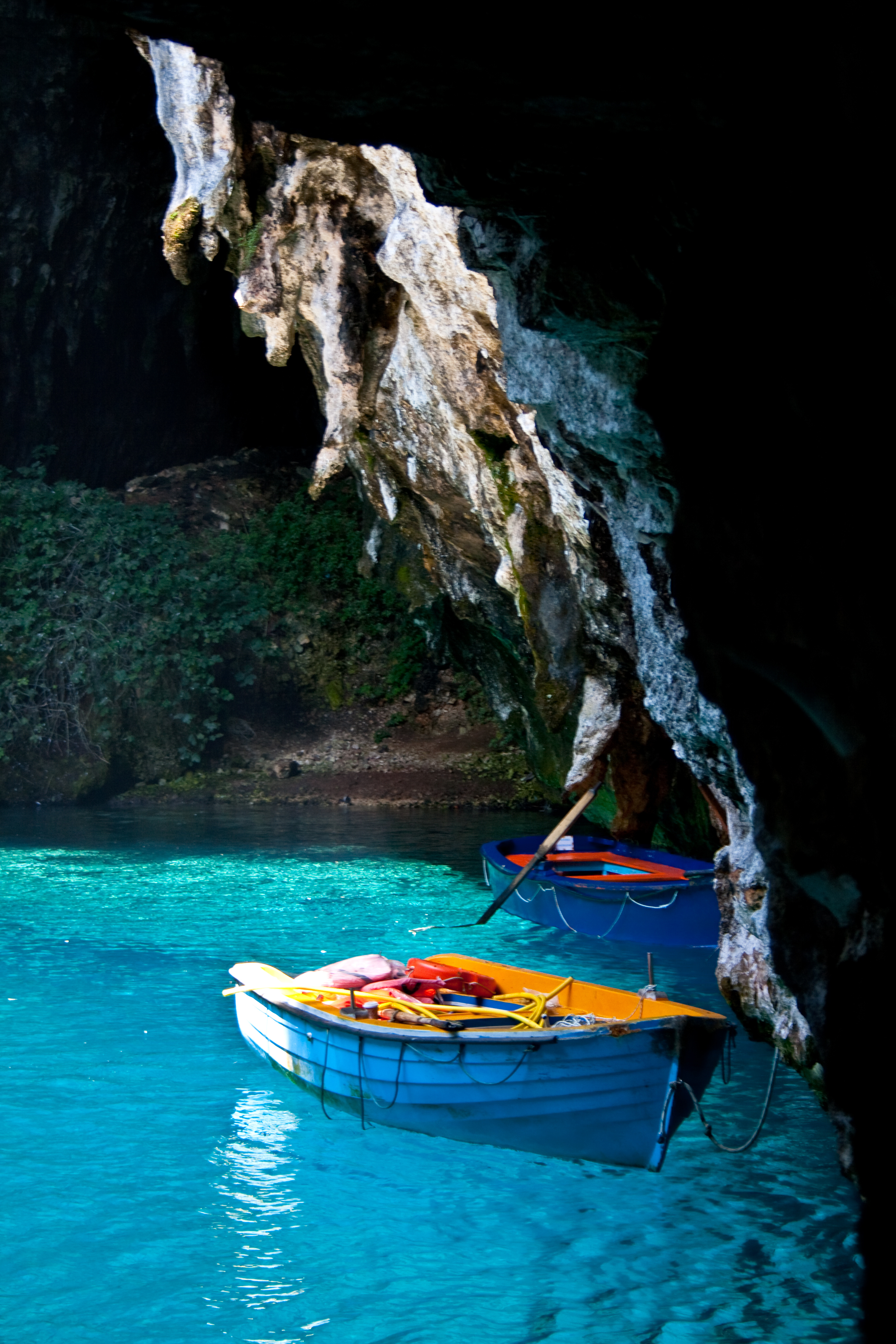
Sites
ThE VILLAGE OF ASSOS
A very picturesque village, thanks to both its traditional architecture and its colorful, narrow alleyways. It’s located on the neck of a small peninsula with a winding road that leads to a castle with magnificent 360° views.
THE VILLAGE OF FISCARDO
A former fishing village that has been transformed into a popular cosmopolitan resort without losing its quintessential island charm.
HISTORICAL AND FOLKLORE MUSEUM OF ThE CORGLALENIOS lIBRARY
A lovely museum nearly hidden under a public library, this establishment houses exhibits of island life, including costumes and old photos of life dating from before the earthquake in 1953. It offers a real sense of everyday life and the living standards of the people of Cephalonia over the past few hundred years.
MELISSANI AND DROGARATI CAVES
Melissani Lake, a hauntingly beautiful sort of “cenote, ” or sinkhole within a cave, is a unique phenomenon created by the erosion of calcerous rocks. The Drogarati Cave, discovered 300 years ago, is filled with stalactites and stalagmites.
ThE ARCHAEOLOGICAl MUSEUM OF ARGOSTOLI
The museum displays artifacts from prehistory up to Roman times in an interesting and informative format.
MONASTERY OF AGHIOS GERASIMOS
Passing through the vineyards of Mount Ainos (and very close to the Orealios Gaea Winery), you’ll find a monastery dedicated to the patron saint of the island. The interior is tranquil and beautifully decorated, while the monastery’s church houses the holy relics of the saint himself.
Activities
SWIMMING
Enjoy the crystal-clear beaches of the island: Kimilia, Emblisi and Myrtos beaches in the north, Petani Beach in the west and Makris Gialos Beach in the south.
BOAT TRIPS AND CRUISES
Choose one of the local boat tours for a fun day out on the water. Boats usually stop in three different locations for sightseeing and swimming opportunities.
Wine and Food
BEST LOCAL FOOD INGREDIENTS
Fava bean spread • Octopus in wine sauce • Marinated anchovies Fresh grilled fish • Feta from Cephalonia • Thyme and spruce honey • Strapatsada (eggs with tomatoes) • Bourbourelia, a soup made with mixed beans • Kreatopita, a meat pie • Bakaliaropita, a cod pie • Rabbit stew • Riganada: bread slices with oregano and local feta cheese • Mandola: a sweet delicacy made of almonds and sugar • Pastokidono (or Komfeto): quince bars, enriched with roasted almonds and honey
A SELECTION OF CEPHALONIA WINES TO TRY
WHITE: Orealios Gaea; San Gerasimo, Robola of Cephalonia • Gentilini; Robola of Cephalonia • Sklavos Estate; Vino di Sasso • Melissinos-Petrakopoulos; Robo- la of Kefalonia • Orealios Gaea; Robola of Kefalonia Barrel • Gentilini; Wild Paths, Robola of Cephalonia • Foivos Wines; Pan- drosos (Tsaousi, Vostilidi, Musca- tel, Muscat) • Haritatos Vineyard; Moscato
RED: Gentilini; Notes Red • Haritatos Vineyard; Mademoiselle Haritatou Mavrodafni • Gentilini; Eclipse Mavrodafni • Orgion; Mavrodafni 2016 • Gentilini; Syrah 2011 • Haritatos Vineyard; Mavrodafni
SWEET: Foivos Wines; Methyse PDO Mavrodafni of Cephalonia
Main Grape Varieties
ROBOLA: the island’s main white variety. It is a citrus-scented grape that grows in the limestone and gravel soils responsible for its characteristic minerality. It is found in the designated Robola zone, in the central part of Cephalonia, in vineyards whose elevations range from 350m to 750m.
MAVRODAFNI: A red grape variety which used to be vinified exclusively for the production of sweet wines. Today, dry wines that are made from it are full bodied, with aromas of red fruit and licorice.
TSAOUSI: A white variety which produces wines with sweet citrus aromas.
OTHER VARIETIES: Moscato, zakynthino and Vostilidi.
Climate and Soils
Conditions are generally mild, but heavy rainfalls and high humidity may result in fungal diseases such as mildew and botrytis. Most vineyards are bush trained. The soils are limestone and gravel in the mountainous areas (mainly in the Robola zone), while in the area around lixouri, where Mavrodafni grows, soils are mainly clay.
Cephalonia wine route
Sclavos Winery
 Evriviadis Sclavos in his cellar.
Evriviadis Sclavos in his cellar.
Arriving in Lixouri by sea, we made Sclavos Winery, located just a few kilometers from the port, our first stop. Having already tasted some wines from here in a series of tastings in Athens, we were intrigued by the personality they projected and were very eager to meet the man behind the bottles. Evriviadis Sclavos has become something of a local legend. A softspoken man, dedicated to the biodynamic approach of vinegrowing and winemaking, Sclavos doesn’t like to speak about himself but loves to talk about his vines. Being one of the most passionate producers of natural wines in Greece, he is dedicated to continuing the winemaking tradition of his family, but he’s also not shy about introducing new methods and carrying out whatever experimentation is required to enable him to produce highquality wines.
The family’s first vineyard in Cephalonia was planted in 1919, by Sclavos’ grandfather, who had left Odessa to return to the country, and the island, of his own grandfather’s birth. Ironically, that man, Sclavos’ great-great grandfather had emigrated to czarist Russia in the 1860s to establish a winery there. Today, the vineyard around the winery in Cephalonia, a 6-hectare parcel of land, is itself surrounded by olive groves and cypress trees; It is a truly beautiful spot, imbuing its visitors with a sense of calm and serenity.
“All of the natural surroundings contribute to the evolution of the vines,” explained Sclavos, stressing the fact that there is absolutely no human intervention with the natural environment. The vines are natural bush vines trained via the “gobelet” pruning method. The winery owns a total of 32 hectares, including a parcel of the original vineyard planted by his grandfather, which is cultivated following the practices of biodynamic farming .The average yield figures for all of the wines here rarely rise above 30 hl/ha, with some going as low as 16 hl/ ha. The vines, which are not irrigated, benefit from the unique limestone terroir of the Robola Zone in eastern Cephalonia under the slopes of Mt. Ainos, and from the limestone, clay, and sandstone soils of the Paliki peninsula. The main variety cultivated here is Mavrodafni, a red variety which has been used in Greece, mainly in the area of Patras, to produce sweet wines. It was Sclavos who proved the immense potential of Mavrodafni, being the first producer in Greece to make a dry wine, one with a dense color and mature red fruit aromas, from this variety. Other indigenous varieties are cultivated as well, including Vostilidi, Ζakinthino and Tsaousi.
Inside the winery, the biodynamic calendar hanging on the wall indicates whether it is a good day for wine tasting or not. For us, it turned out that the day was perfect to taste the wines. The winery’s young and very talented oenologist Evaggelia Moraiti told us that the calendar provides vital information during the different winemaking processes that produce all their wines, a total of 10. She also pointed out that, because the winery believes in intervening as little as possible in the natural process of winemaking, they use sulfites only when it is absolutely necessary, employ only natural yeasts for the fermentation process, and do not filter the majority of their wines.
The winery produces about 70,000 to 10,000 bottles per year, 50% of which are currently exported to markets abroad, including the United States, Canada, Japan, France and the U.K. “For us, the production of natural wines is not a marketing tool. It is a philosophy we truly believe in,” Sclavos told us. As we strolled between the fermentation tanks, we stopped to try two different versions of Robola, one from the higher altitude vineyard and one from lower down. The versatility of this variety, which Sclavos compares to Assyrtiko and even Riesling, was immediately evident. As we proceeded to the winetasting area, Sclavos showed us a map of Cephalonia; pointing to the peninsula of Paliki, he told us that Odysseus, Homer’s home sick hero, came from this part of Cephalonia instead of the presentday island of Ithaka. “This area used to be an island”, he said. “This is the orginal Ithaka.” It was a theory we would hear several times during our stay on the island.
WINE TASTING
 Some of the wines produced by Sclavos winery.
Some of the wines produced by Sclavos winery.
At the tasting, we tried a Zakynthino 2016, a dry white wine from the slopes of Aenos, vinified according to the principles of natural winemaking, unfiltered and without the use of sulfites; and a Vino di Sasso 2017, the winery’s Robola and one of the most interesting vinifications of Cephalonia’s most famous variety. This Robola is a deep and complex wine, with apricot aromas and some hints of petrol.
We also sampled an Οrgion 2015, the winery’s signature wine, a red made from 100% organically farmed Mavrodafni, grapes; this was a wine with excellent fruit concentration and aromas of mature red fruit as well as some meaty notes. We ended with a Synodos 2016, the winery’s second red wine, an organic, unfiltered wine resulting from the covinification of red Mavrodafni and the white grape Vostilidi (sourced from 40-year-old bush vines). A terroirdriven wine, this selection features black cherry and plum aromas.
Kehrionas, lixouri 28200 T: (+30)26710 91930, (+30) 694 600 0748 Visits by appointment
Κtima Ηaritatou
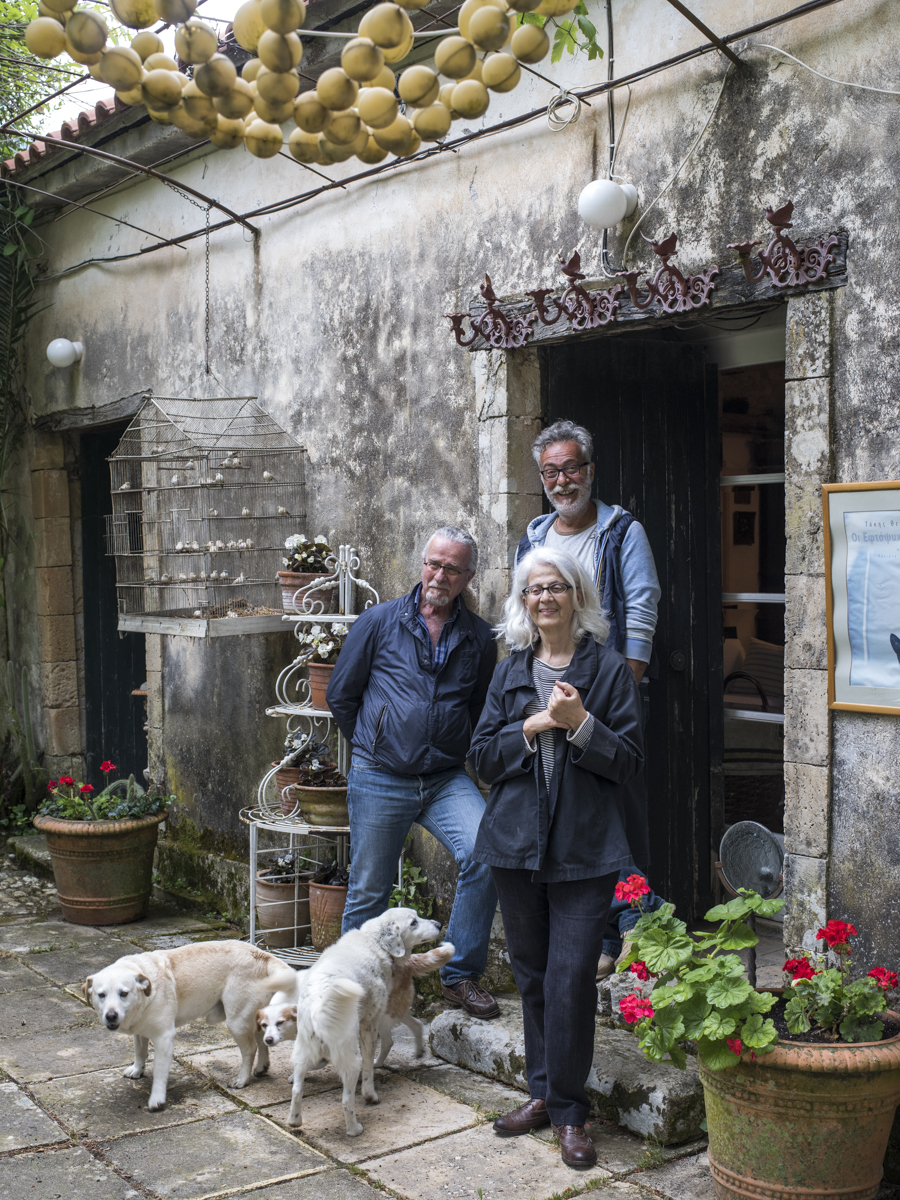 The haritatos’ family haritos (left), Ioanna (center) and Costas, with their four- footed friends.
The haritatos’ family haritos (left), Ioanna (center) and Costas, with their four- footed friends.
The road which was to lead us to our next destination was closed; a victim of the last big earthquake which rocked the island in 2014, it is still under repairs. Instead, our helpful GPS took us down a series of picturesque back roads which eventually brought us to a small well hidden paradise in the area of Monopolata. A white-haired man with a broad smile greeted us as we pulled up, introducing himself as Costas Haritatos. Moments later, he was joined by an elegant white haired lady; this was his sister, Ioanna Haritatou. When Haritos Haritatos, a pharmacist who went on to study oenology in order to help out the new family business, arrived as well, we were in the presence of the members of the Haritatos family who decided five years ago to turn the family-owned property into a wine-producing unit.
The family’s roots can be traced back to AD 1400, when the island was ruled by the Venetians. “The family property has never changed hands; it’s always been owned by our family” explained Ioanna. The old farmhouse is an important part of the family’s long history. For 200 years it has stood here, despite earthquakes which have, unfortunately, not left it unscarred. A beautiful, well-tended garden surrounds the house, hosting all kinds of Mediterranean plants. The 120-acre holding is a fully-functioning farm, with the vineyard playing a central role. Olive groves, walnut trees, fig trees, mulberry trees, cherry trees and a small forest of cypresses cover much of the land. We saw chickens, ducks and geese, as well as a number of dogs, all moving about happily in typical farmyard fashion. It was easy to imagine all the happy moments the Haritos family and their guests had shared in these marvelous surrounding.

“Five years ago, we decided to start producing our own wine from our grapes,” Ioanna said. “Until then, we’d been selling them to other wine producers in the area.” It was a decision that really changed their lives. They’d had very different careers; Ioanna had served as a press attaché in Greek embassies around the world, spending many years living abroad; Costas had just returned from Rome, where he had spent the previous 20 years; and Haritos, who lived on Cephalonia, had been a pharmacist. Today, they are dedicated to reviving this historic farm.
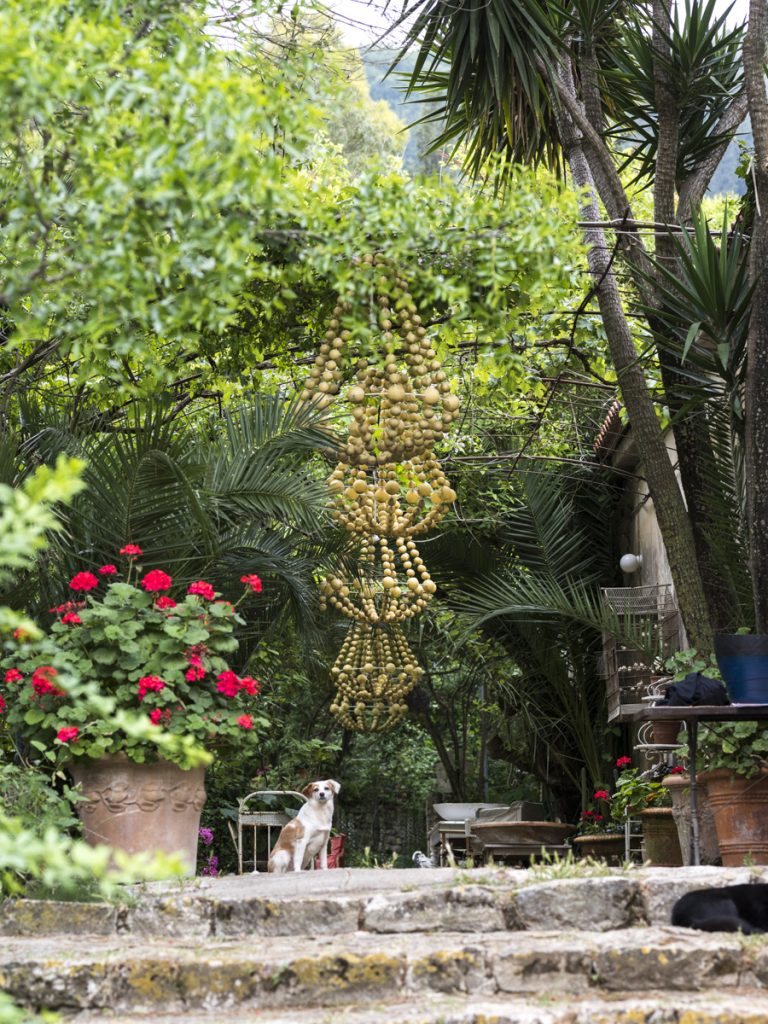 On the grounds of the family home.
On the grounds of the family home.
The vineyards have been planted with two of the island’s three main indigenous varieties, Mavrodafni and Moscato, and the family follows the principles of organic farming. A small amount of the lesser-known white variety of Vostilidi has been planted as well; it’s used to produce the winery’s newest addition, Hariton, which was bottled for the first time this year. They work closely with oenologist Christos Peppas on the production of the winery’s four wines. This is a boutique winery, producing around 40,000 bottles annually. It is currently open to visitors by appointment; in the near future, the winery will also have a selling point for its wines and will host organized tours and wine tastings.
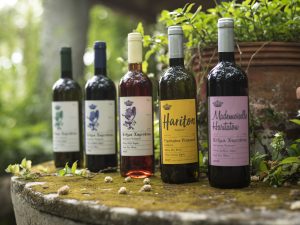
Sitting in the estate’s lovely garden, we tasted all four wines; a Ktima Haritatou 2014, a red made from 100% Mavrodafni; a Mademoiselle Haritatou 2016, a fresh red also made from Mavrodafni; a Hariton 2017, 100% Vostilidi; and a Ktima Haritatou White 2017, an aromatic wine made from 100% Moscato.
Kladata, lixouri 28200 T: (+30) 697 344 6352, (+30) 697 610 8768
Gentilini Winery
Established in the 1980s by Spiros Kosmetatos, Gentilini Winery is responsible for making Robola famous both in Greece and abroad. The winery owes its name to Kosmetatos’ paternal grandmother Mariana Gentilini, the last noblewoman in her line. (Her ancestor Marino Gentilini, an Italian army engineer, was commissioned by the Venetian Senate in 1593 to build the extensive Assos fortifications on Cephalonia. He eventually married and settled here, and his name was inscribed in the Libro d’Oro of noble families.
In 1929, Gerassimo Cambitzi opened one of England’s first wineries, Isleworth Wineries, a little outside London. Thirty-five years later, his grandson, Spiros Kosmetatos, planted his first vineyard of local and classic white grape varieties on Cephalonia. Having studied the latest techniques to identify the oeno- logical processes best suited to the climate, soil and varieties of the area, Kosmetatos released the first commercial vintage of Gentilini in 1984, simultaneously in Athens and London. At the time, he was a pioneer in fine winemaking in Greece, paving the way for those boutique wineries that followed.
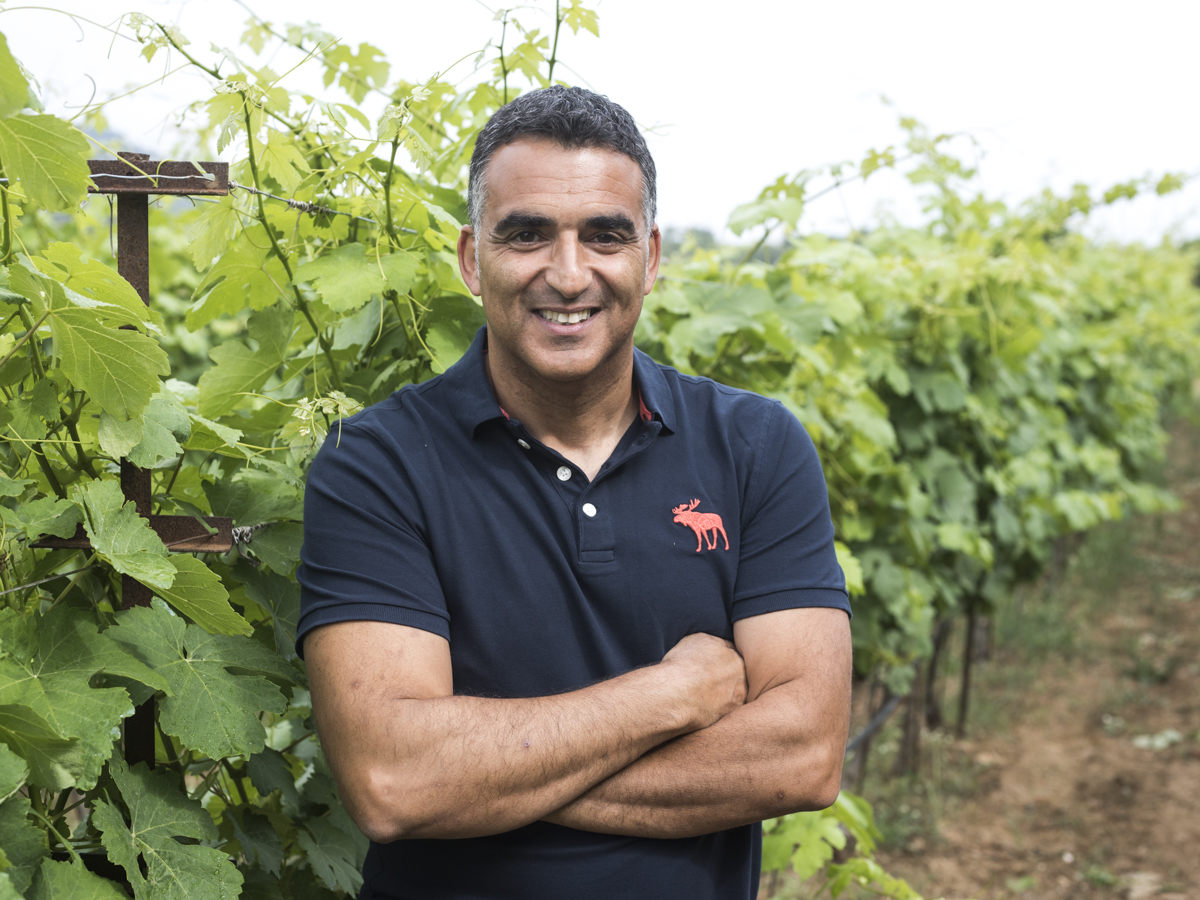 Petros Markandonatos Sales and Exports / Co- Owner.
Petros Markandonatos Sales and Exports / Co- Owner.
Today, the winery has passed to the next generation. Spiros’ daughter, Mariana, and her husband, Petros Markandonatos, took over the estate in 2002. A highly energetic man, with a strong vision of how to make Robola the next signature Greek white wine variety (after Assyrtiko), Markandonatos divides his time between Cephalonia and abroad, mainly Australia, where he is co-operating with Pulmora Estates, a winery that is planning to produce Robola wines in the Barossa Valley.
Markandonatos came straight from the airport to welcome us to the estate. He’d arrived a day ahead of schedule just to meet us, and he was pleased to take us around the 10-hectare vineyard, planted mainly with Mavrodafni, which is organically farmed. “With the latest additions, this is becoming a very significant Mavrodafni vineyard,” he explained proudly as we walked up towards the family house, which stands a top a hill and enjoys breathtaking views of the seashore. Back in the openair tasting area, we noticed a couple of American visitors enjoying their wine, engaged in a lively conversation with Markandonatos’ niece, Nora, who’s responsible for organizing the visits. “We welcome about 4,000 visitors per year,” Markandonatos explained, “all either by appointment or as walkins − no tour groups − and give them a short tour of the estate and production area, as well as tasting flights of Robola and the winery’s other selections.

“This is a small, boutique winery and we’d like to keep it that way. We don’t want to add any more buildings; that would spoil the really beautiful natural surroundings. “Mariana, his wife, is in charge of the winery’s management, while he’s responsible for the production, sales and exports. The team is completed by oenologist Alexandros Doukas, head winemaker, and young oenologist Theodoris Theodoridis. The winery produces nine wines for a total of 120,000 bottles, a large percentage of which is for export, mainly to the United States and Australia. We tried Notes 2017, an easy-drinking white wine. It’s a blend of Tsaousi and Sauvignon Blanc, a modern version of the first wine that was vinified by the company in 1984. We then moved on to a Robola of Cephalonia 2017, a fresh, crisp white wine, with all the minerality of a typical Robola, before sampling a Wild Paths 2016, made from Robola grapes sourced from the oldest vineyard in the Robola Zone. This is a complex white wine which expresses the minerality and acidity of the variety. We finished up with a Gentilini Rosé 2017, a rosé wine from Moschofilero, and an Eclipse 2016, a red wine made from Mavrodafni, with aromas of red fruit and licorice, which matures for at least 12 months in French barriques and American barrels.
Minies 20100
T: (+30) 693 271 8730 gentilini.gr
Oreallios Gaea (Robola Cooperative of Cephalonia)
 View of Oreallios Gaea winery.
View of Oreallios Gaea winery.
Located in the heart of the Robola Zone, the Cooperative of Cephalonia is the largest production unit on the island, with a total annual production of 500,000 bottles. It was established in 1982 with the participation of 60 grape growers. Vinification took place outdoors until 2006, when the new winery was built and new equipment was brought in. Today, the cooperative has 300 members, all growers in the Robola Zone (which covers the Valley of Omala). The vineyards begin at an elevation of 450 meters and reach 800 meters.
The climate of the area is characterized by long rainfalls during the winter months -this phenomenon can extend into spring and early summer, sometimes disrupting maturation − and there are occasional heat waves. The greatest asset of the area is the wide diurnal range, with warm temperatures during the day and really cool nights. The wines produced are characterized by the natural acidity of the Robola grape and by minerality coming from the limestone and gravel soils. A small part of the production goes through barrel ageing; the majority is bottled fresh. The winery is open to visitors, and approximately 70,000 to 80,000 people come to the site each year to enjoy a short tour and wine tasting sessions. A new area for wine tasting is currently being built and is expected to begin operating by the end of July. The company is also preparing a new brand, Oreallios Gaea, under which it will market all its wines. The vinification process is supervised by the cooperative’s chief oenologist, Kostas Nodaras, while the cooperative’s general manager is Costas Bazikos, a chemist by training, who was kind enough to offer us the tour and organize the wine tasting.
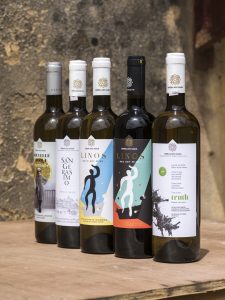
The winery’s most popular selection is its Robola of Cephalonia with a characteristic bottle. This is a typically light easy drinking expression of Robola and a bestseller with those who wish to take a souvenir from the island home with them. We also tasted the barrel-aged version of the same wine, Robola of Cephalonia 2015, a wine with notes of vanilla and honey, with good acidity. Another Robola, San Gerasimo is much more aromatic, coming from the higher altitude vineyards, with good acidity, more fruit concentration and a longer aftertaste. This is a food-friendly wine, and a perfect match with seafood and with the local cuisine. The winery also produces Truth, a Robola from organically farmed vineyards, a wine with stronger notes of botanic aromas (chamomile) and Nouvelle Epoque, a wine produced from the lesser-known white variety Vostilidi, which had nearly become extinct before it was rediscovered and vinified, producing wines with a more tannic taste. This wine comes from newly planted vineyards. The winery’s other options include Linos White, a dry white blend of Moscato and the island’s lesser-known varieties of Ζakinthino and Tsaousi, and Linos Red, a dry red made from 100% Mavrodafni.
T: (+30) 26710 86301 robola.gr
Melissinos Winery
Hidden away in the southern part of the island, Melissinos is the third winery open to visitors in the area of Argostoli. Today, a stone building that was once the summer house of the Solomos family − it was rebuilt after the 1953 earthquake that flattened the area − hosts this small winery, established in 2002.
 Melissinos’ Oenologist, Kiki Siameli.
Melissinos’ Oenologist, Kiki Siameli.
The winery is run by Kiki Siameli, a young oenologist responsible for the production of the winery’s 12 wines. Her approach to vinification is based on a philosophy of intervening as little as possible in the natural winemaking process, and a large portion of the grapes used are sourced from organically farmed vineyards. The small yard at the back of the building, surrounded by olive trees, lemon trees and colorful rose bushes, provided the perfect spot for the wine tasting. Although it was early in the morning, we were more than willing to sample 10 of the winery’s 12 wines, all under the guidance of Kiki, who offered us details regarding the sourcing of the grapes and the vinification techniques used for each selection.
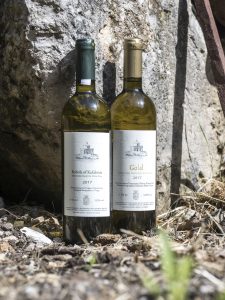
We had the opportunity to compare three different versions of Robola: a Robola 2017, a typical Robola with high acidity and strong minerality, made from grapes sourced from two high-elevation vineyards (700m); a Bio Robola 2017, coming from the best Robola vineyards in the area of Fagias, which yielded a more aromatic version with less minerality; and Νatural 2017, a naturally fermented wine made according to a traditional wine making process. We also tasted a Zakynthino Gold 2017, a dry white made from the indigenous variety Zakynthino, a grape which offers good natural acidity and which, thanks to its high phenolic character, has a great ageing potential. The winery’s two red wines are made from Mavrodafni; the Mavro 2015, a blend from two different vineyards, and the Mavrodafni 2015, a wine produced from grapes sourced from a prephylloxera vineyard, with strong botanic character and very good concentration of the fruit, were both barrel-aged for a year (the latter has a longer ageing potential).
Thiramona 28086
T: (+30) 26710 29716
Foivos Winery
Located in the area of Vouni near Lixouri, Foivos Winery is considered to be the continuation of the Matzavinos Winery, one of the two historic wineries of Cephalonia. In 1999, a new effort began, aiming at developing indigenous varieties of Cephalonia according to the principles of natural winemaking, with the least possible human intervention.
The winery produces 25 different wines, both varietals and blends from the island’s indigenous varieties. The grapes are sourced from organically farmed, privately owned vineyards and from other growers working in cooperation with the winery. The winery is open to visitors. Unfortunately, we didn’t have the chance to visit the winery or taste any of its wines. ●
Santorini | text by Thalia Kartali & Penelope Katsatou |Photography by G. Kaplanidis | issue 10
One of the Cycladic islands, Santorini (official name Thira) sits in the Aegean Sea. It was known as Strongili (the Round One) until, thousands of years ago, a colossal volcanic eruption caused the center of the island to sink, leaving a caldera (or crater) with towering cliffs along its east side now Santorini’s trademark landscape. The breathtaking views from the caldera and the famous sunsets as seen from the island have made Santorini one of the most recognizable destinations in the world. The island is also the leading producer of Greek white wines, in terms of quality and true character. The soil of Santorini is a mix of volcanic lava, pumice and ash deposits, resulting in vineyards completely free of phylloxera. The number of quality restaurants and top wineries is impressive, which makes it the perfect destination for travelers who are seeking authentic, memorable culinary experiences.
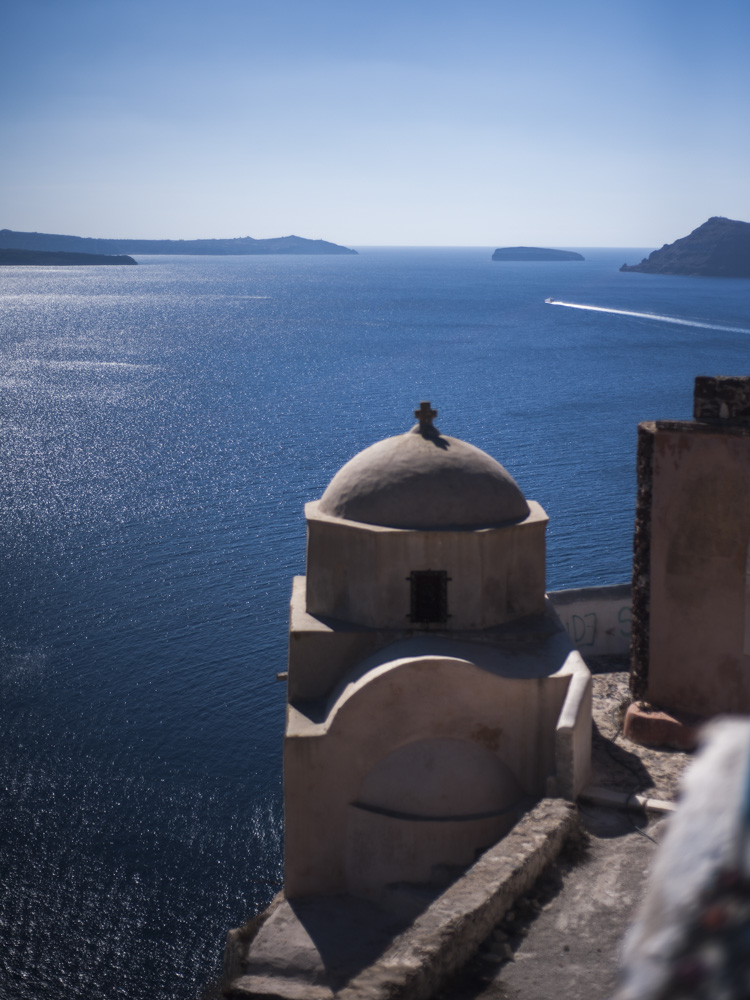
Ancient Sites
ARCHAEOLOGICAL MUSEUM (Fira)
Admire sculpture from the Archaic to the Roman period, as well as vases and clay figurines dating from the Geometric to the Hellenistic periods.
MUSEUM OF PREHISTORIC THERA (Fira)
Take a look at the urban planning and architecture of the ancient city of Akrotiri. One can also find fossils of plants here that flourished before the human habitation of the island, as well as archaeological objects.
ANCIENT THERA (Near kamari)
This is an ancient city on a ridge of the steep 360m-high mountain Messavouno. Visit to check out the Agora, the Basilica Stoa and the theater.
AKROTIRI ARCHAEOLOGICAL SITE
The archaeological site of Akrotiri is one of the most important ones in the eastern Mediterranean. You’ll have the opportunity to walk along the ancient streets and squares of the city, visit dwellings and religious ritual areas and see workshops, cookhouses, facilities for storage and more. Details preserved from the moment the volcanic eruption doomed the city testify to the dramatic termination of life at Akrotiri.
ACTIVITIES HIKING
The trail that connects Fira with Oia offers hikers spectacular views.
SWIMMING
Perissa Beach, Kamari Beach, Perivolos Beach and Vlychada Beach.
WATERSPORTS AND MORE
Waterskiing, jet-skiing, scuba-diving and snorkeling, boat tours and paragliding.
OTHER VISITS
The Tomato Industrial Museum; Santorini Brewing Company; S.M.A.G (Spira Marble Art Gallery)
Wine and Food
BEST lOCAL FOOD INGREDIENTS
Capers • Cherry tomatoes • White eggplants • Fava beans • Hloro tyri (goat cheese) • Dhomato keftedes (tomato fritters) • Meatballs • Kardamides (green herbs) • Peanuts • Honey • Fresh fish and other seafood • Fried cheese in filo pastry covered in honey • Santorini salad (capers and cucumbers • Tomatoes and local cheese)
WORTH VISITING SANTORINI WINERIES
Domaine Sigalas • Estate Argyros • Hatzidakis Wines • Vassaltis Vineyards • Gaia Wines • Boutari Wines • Canava Chrisou – Tselepos • Santo Wines • Venetsanos Winery • Gavalas Winery • Canava Nomikos • Karamolegos Winery and Volcan Wines
Santorini wine info
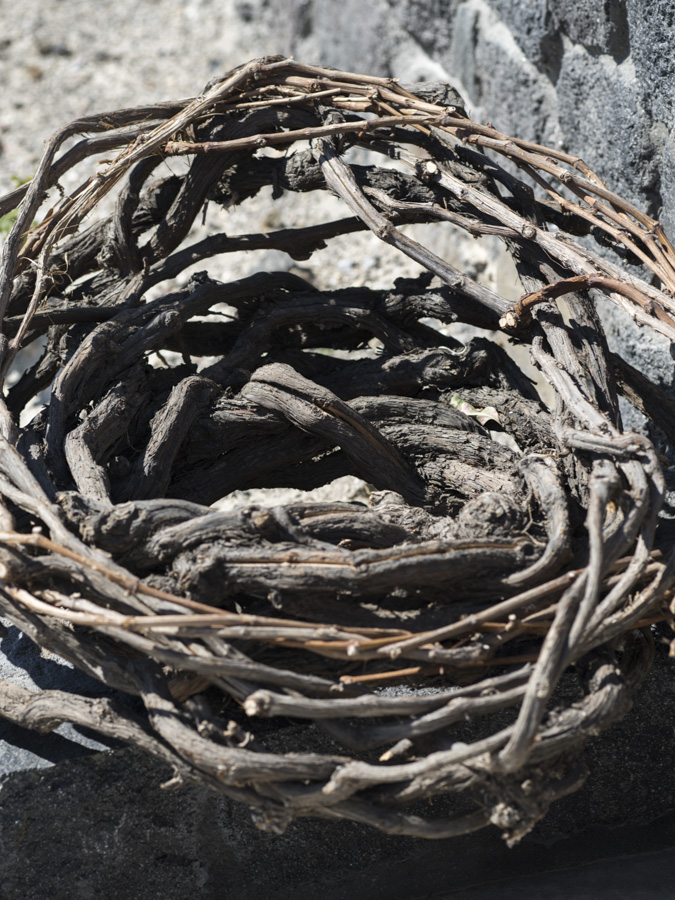
KOULOURA
The traditional way of training Santorini’s vines into a basket-like shape in order to protect them from the strong winds and the high summer temperatures.
CANAVA
The term of a traditional winery in the local dialect. Usually rockhewn underground or protected by nearby buildings.
ASSYRTIKO
Santorini’s signature white grape variety, it’s rapidly gaining worldwide recognition. It produces wines of medium aromatic intensity but with strong minerality that is characteristic of the island’s wines and has a great ageing potential.
A white grape variety used in a blend with Assyrtiko to produce Santorini wines such as Nychteri and Vinsanto. Vinified as a vari- etal, it produces wines of a floral character with aromas of tropica
ATHIRI
A white grape variety that is also used in the blends of Santorini wines; when vinified as a varietal, it can give wines of a fruity character with medium to low acidity.
MAVROTRAGANO
A very rare red variety from San- torini that was, until recently, at risk of extinction. The variety combines dense red fruit with roasted coffee and smoke, robust tannins and a rich and mineral mouth.
VINSANTO
Santorini’s sweet wine, made predominantly of Assyrtiko, with Aidani and Athiri also participating in the blend. It’s made from lateharvest grapes which dry in the sun for 12-14 days. It ferments and then ages for at least 24 months in oak barrels.
NYCHTERI
Santorini’s traditional wine, made from a blend of Assyrtiko, Athiri and Aidani. Grapes destined for Nychteri were pressed during the night after the harvest, to protect the juice from the heat of the day. Its name is derived from the Greek word “nychta,” which means “night.”
Santorini wine route
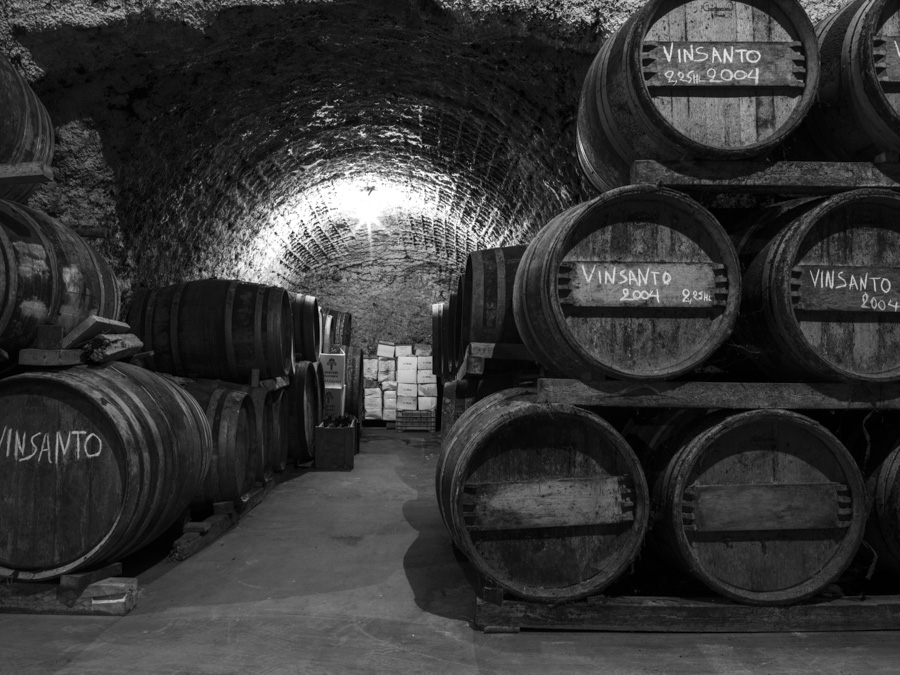 The wine cellar, 12 meters long, in the hatzidakis Winery.
The wine cellar, 12 meters long, in the hatzidakis Winery.
Hatzidakis Winery
Αrriving at the Hatzidakis Winery in the area of Pyrgos, we immediately agree with one another that this is what a winery in Santorini should look like. Carved into the soft but solid volcanic rock that forms the island’s soil, this winery, or “canava” as it is called in the local dialect, consists of a cellar, 12 meters long, where all the winery’s barrels are kept. The rest of the winery was built in 2004 as an addition to the old canava, which was not big enough for the 130,000 bottles that are currently produced and of which 50% are exported to markets around the world. Xaridimos Xatzidakis, who passed away last year, was a passionate man dedicated to getting the best out of what Santorini’s unique grapes have to offer.
In a dark corner, a long wooden table is set up for the tastings; the atmosphere is perfect for the excellent wines we are about to taste. The winery’s signature wine is Assyrtiko de Louros, a wine made from late-harvested grapes from selected vineyards, some of which are 150 years old. Dense and mineral on the palate, with typical acidity and a long aftertaste, this wine pairs perfectly with shellfish, and with white and red meat and mature cheeses. It can age for more than 10 years in the bottle. During our visit, we had also the pleasure of tasting the winery’s main selection, Santorini 2016, a wine (made from 100% Assyrtiko) that undergoes stainless steel fermentation and remains unfiltered, a typical, easy-drinking Assyrtiko.
We also sampled the Nychteri, the traditional wine of Santorini, also 100% Assyrtiko from late harvest over-matured grapes, vinified using more modern techniques and less oak. We could not have left the winery without tasting the Vinsanto, Santorini’s traditional sweet wine, which, at this winery, is made from Assyrtiko and Aidani, spends 14 years in the barrel, has a perfect balance between acidity and sweetness and boasts aromas of apricot marmalade. hatzidakiswines.gr
Boutari Winery
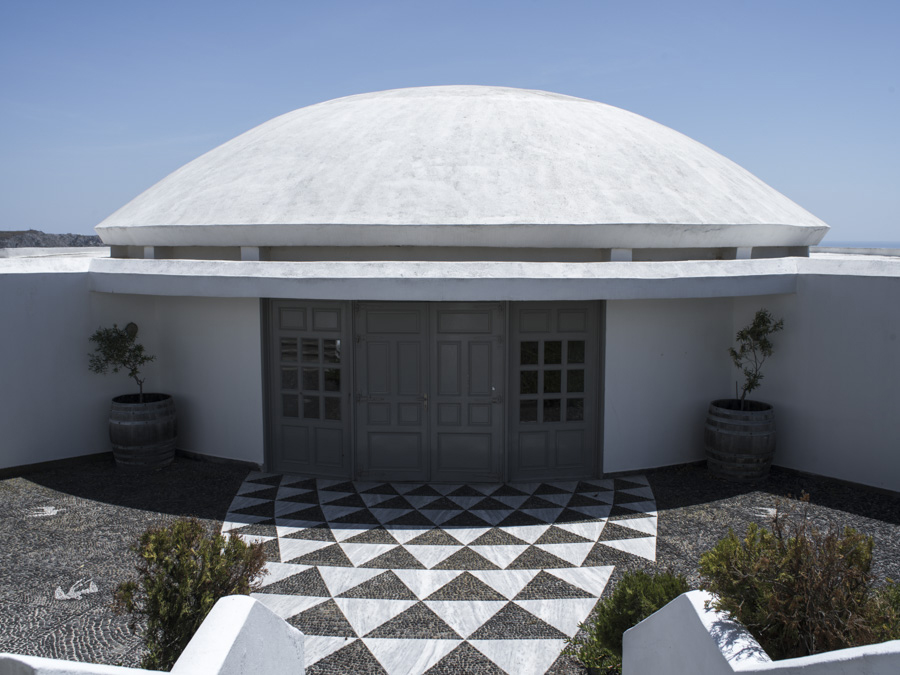 Boutaris’ state-of-the-art winery.
Boutaris’ state-of-the-art winery.
A pioneer in many ways, Boutaris landed on the island of Santorini in the ’80s, when the now-famous Assyrtiko variety was practically unknown. The state of the art winery has been distinguished as one of the 10 architecural wonders of the wine world and was the first to open its doors to visitors in 1989. Upon his arrival, Boutaris changed the practice of late harvesting and begun vinifying less ripe grapes, causing an uproar among the traditional winemakers.
Since then, the Boutari Winery has been consistently producing good quality Santorini wines, including Assyrtiko, Nychteri and the traditional Vinsanto; the Vincanto is aged for 12 years in the barrel. During our visit to the winery we had the pleasure of tasting a Santorini 2016, made from 100% Assyrtiko, a fresh and crisp dry white wine, with aromas of orange peel and grapefruit, and the winery’s Nychteri 2015, 100% Assyrtiko which has spend seven months ageing in oak, endowing it with its characteristic aroma of honey.
boutari-santorini.gr
Gavalas Winery
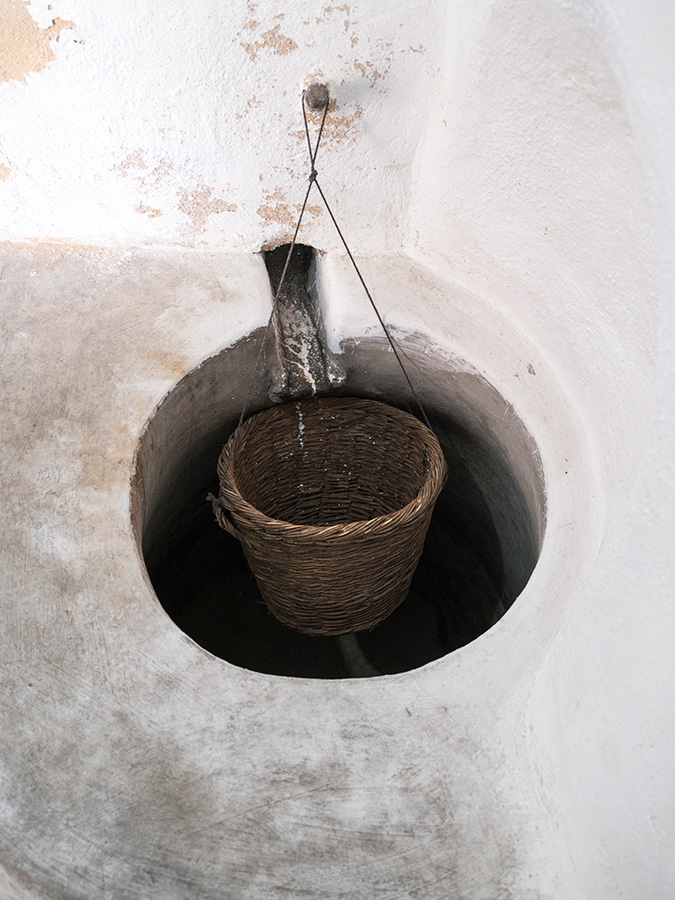 The old reservoir where the juice from pressed grapes ended up for fermentation.
The old reservoir where the juice from pressed grapes ended up for fermentation.
This is a small family owned winery, one of the oldest on the island. Vagelis Gavalas represents the fifth generation of family winemakers. Together with his father George, he continues the family tradition of winemaking, using the traditional method of stomping the grapes for the production of their signature wine, Vinsanto. This wine ferments and ages for six years in 100year-old barrels, made from oak imported from Russia back when the wine export trade to that country was flourishing. The charming courtyard where the wine tastings take place is next to the cellar and the old “patitiri”, where the stomping used to take place. Here, the visitor can also take a look at an antique press and at wicker baskets used for carrying the grapes so as to get a better idea of the traditional winemaking processes of the island. gavalaswines.gr
Gaia Winery
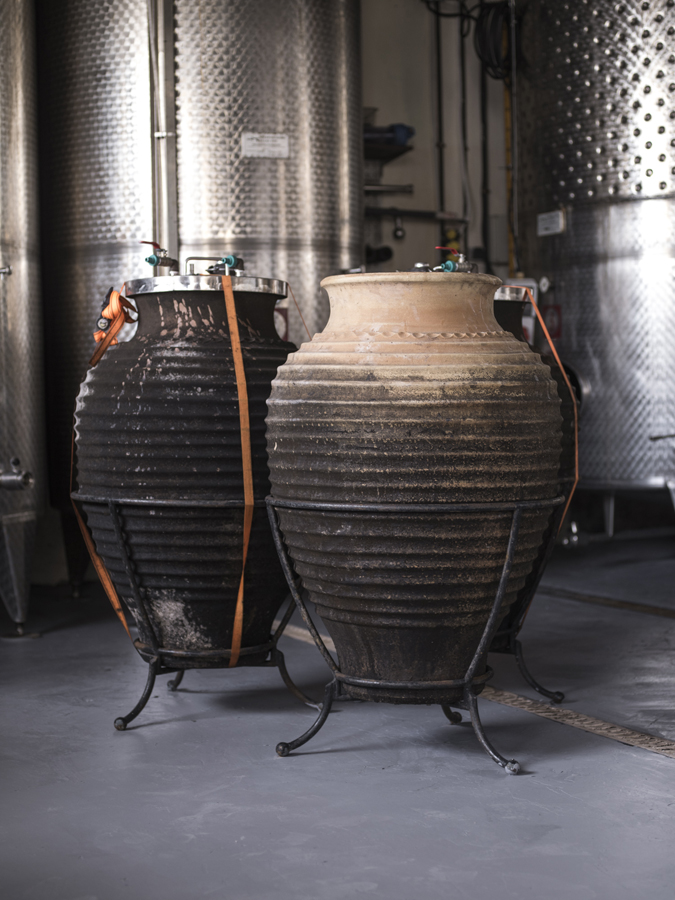 Tradition meets modern winemaking technology at the Gaia winery.
Tradition meets modern winemaking technology at the Gaia winery.
It’s difficult to describe what we’re feeling as we approach this winery, right by the water on the beach of Kamari. There is, certainly, a little jealousy of those who get to work here. The industrial stone building dating from the beginning of the 20th century, which today houses the winery and is equipped with all the high-tech equipment for modern winemaking, used to be a tomato canning factory. A charming area in front of the structure serves as the tasting area, so the tastings take place outdoors by the water’s edge. It is truly a marvelous setting for wine tasting! Here, we have the opportunity to try three different versions of Assyrtiko: Thalassitis, Thalassitis Oak Fermented and Assyrtiko by Gaia Wild Ferment, a wine whose production combinestraditional and modern winemaking techniques, with the use of both Inox tanks and new French and American oak barrels in which the wine ferments withthe use of wild yeast. gaia-wines.gr
Santo Winery
 Breathtaking views from Santo Winery.
Breathtaking views from Santo Winery.
A young man with a warm smile welcomes a group of tourists as we walk through the entrance of Santo Wines. A few steps down and we find ourselves in an impressive modern building, crowded with tourists who have come here to taste some of Santorini’s best wines and get to know – and shop for – the island’s delicacies, all displayed in the winery’s large deli shop. The winery was built in 1992 to house the Union of San- torini Cooperatives, whose wines came to be produced under the name “Santo.”
The building itself resembles the island’s traditional stone benches. Surrounded by breath- taking views of the deep blue sea and the volcano, we taste some of the cooperative’s wines, including Santo Sparkling 2014, the first sparkling wine to be made from 100% Assyrtiko grapes from the vineyards of Pyrgos; Santo Rose Sparkling Demi Sec, made with Assyrtiko and Mandilaria, a fresh, cherry-flavored and very summery wine, with a sweet aftertaste which makes an excellent aperitif (it can also accompany meals); and Santorini Asyrtiko Grande Reserve 2014, a wine made from Akrotiri vines that are up to 100 years old; it’s aged for 12 months in oak and an- other 12 in the bottle.
Naturally, we didn’t skip the Santorini Assyrtiko 2016 or the Santorini Nychteri 2016. While sitting in the winery’s veranda overlooking the Aegean, we can’t help noticing the smiles on the face of the numerous tourists, most of who are from Asia, who were enjoying their own tastings in this unique place.
santowines.gr
Estate Argyros
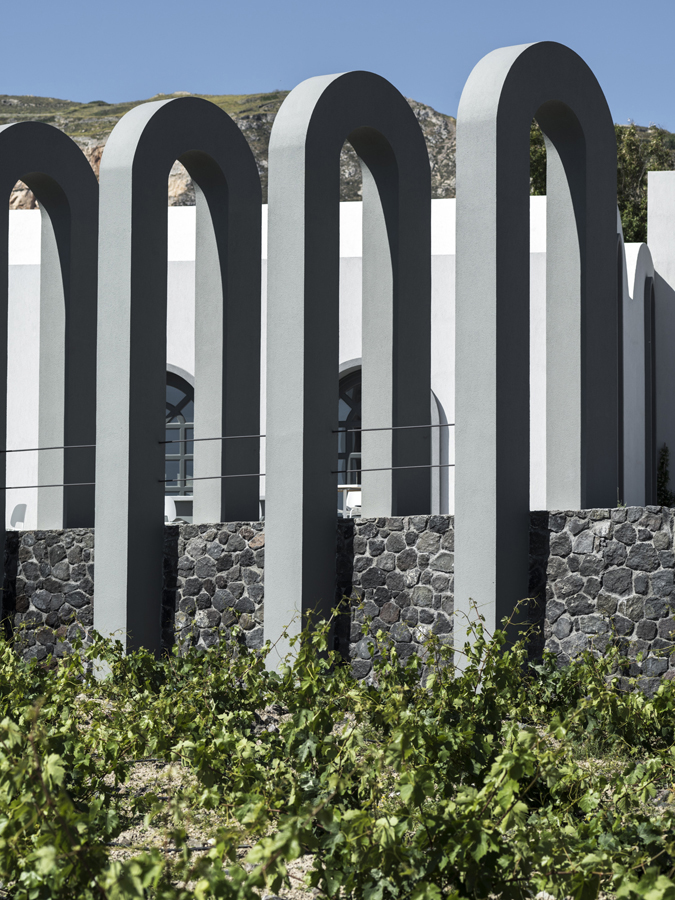 At Estate Argyros, a modern architectural feature designed to remind the visitor of a traditional canava.
At Estate Argyros, a modern architectural feature designed to remind the visitor of a traditional canava.
Arriving at Estate Argyros, we are treated to a totally different side of Santorini. Here on the other side of the island, there are no dramatic views, only vineyards, symbols of the triumph of life over the widespread death caused by the volcano. Surrounded by the privately owned vineyard, the estate’s winery is a modern building designed to remind the visitor of a traditional “canava. The estate, established by George Argyros in 1903, was passed on through the generations. Today, it is run by Matthew Argyros, the fourth generation of winemakers in his family.
The Estate produces wines (from indigenous varieties) which they create by combining traditional and modern winemaking techniques. The grapes come from ungrafted, phylloxera-free vines, some of which are 150 years old. The winery produces 350,000 bottles a year, 60% of which are exported. Here, Assyrtiko finds its different expressions; unoaked in Santorini Argyros and barrel fermented in Estate Argyros. The estate also produces a varietal Aidani, an elegant fresh fruity wine, and a red wine made from Mavrotragano, the island’s rare red grape variety. The Vinsanto spends 12 years in oak and is made from Assyrtiko, Aidani and Athiri ●
estate-argyros.com
Avithos Preview Taverna | Cephalonia | Photography by Giorgos Kaplanidis
Overlooking the beautiful Avithos Beach, the Avithos Preview Taverna offers you a little more than your average Greek taverna. Since 2004, Panos and his mother Angela have been producing delightfully authentic Cephalonian and Greek dishes, using select local products, fresh fish straight from the fishermen at Argostoli harbor, and vegetables from their own organic garden.
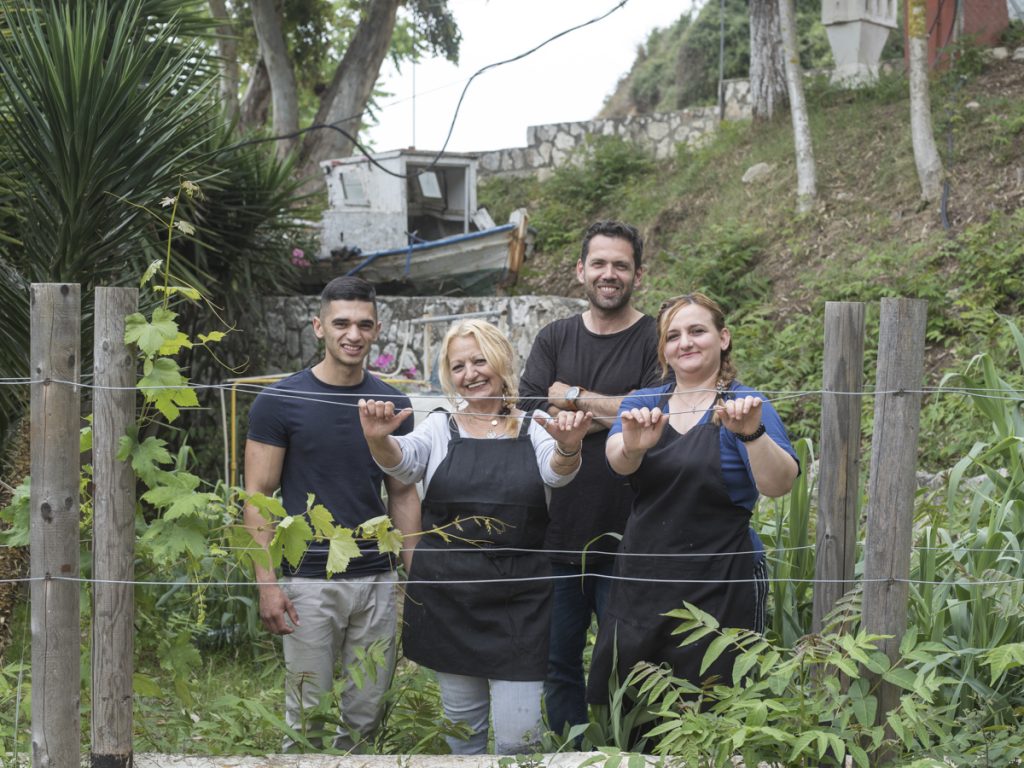 The team at Avithos Preview Taverna.
The team at Avithos Preview Taverna.
Bourgeto (Whitebait in tomato sauce)
4–6 serves
Ingredients
1/2kg whitebait (cleaned, gutted and heads removed) • 100ml olive oil • 3 cloves of garlic, chopped • 3–4 grated tomatoes or 300ml tomato juice • 1/2 teaspoon dry oregano • 1 dry bay leaf • Pinch of rock salt • Juice of half a lemon
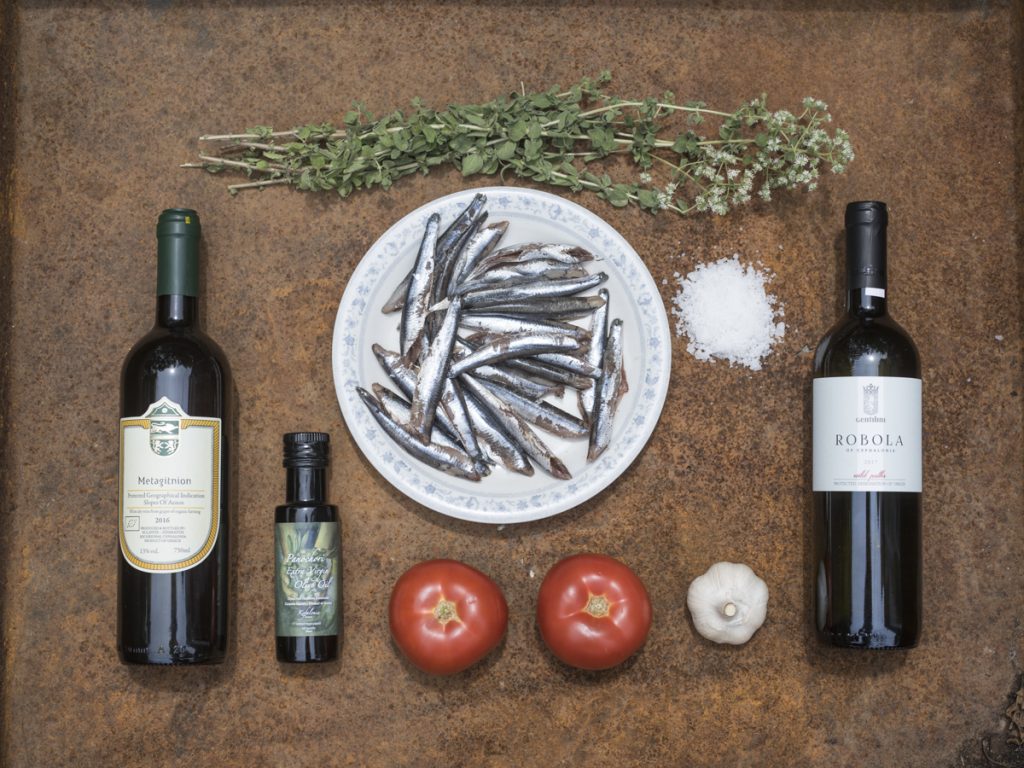
Preparation
In a frying pan, place the olive oil and garlic, and sauté for 2 minutes. Add the tomatoes and stir for 5 minutes. Add the oregano, bay leaf and whitebait. Add salt. Cook for 15 minutes. Add the lemon juice and plate up.
Wine Pairing
Gentilini, Wild Paths, 2017: A limited-production single-vineyard Robola, passed through French and American oak barrels. Aromatic, with rich body, refreshing acidity and long aftertaste.
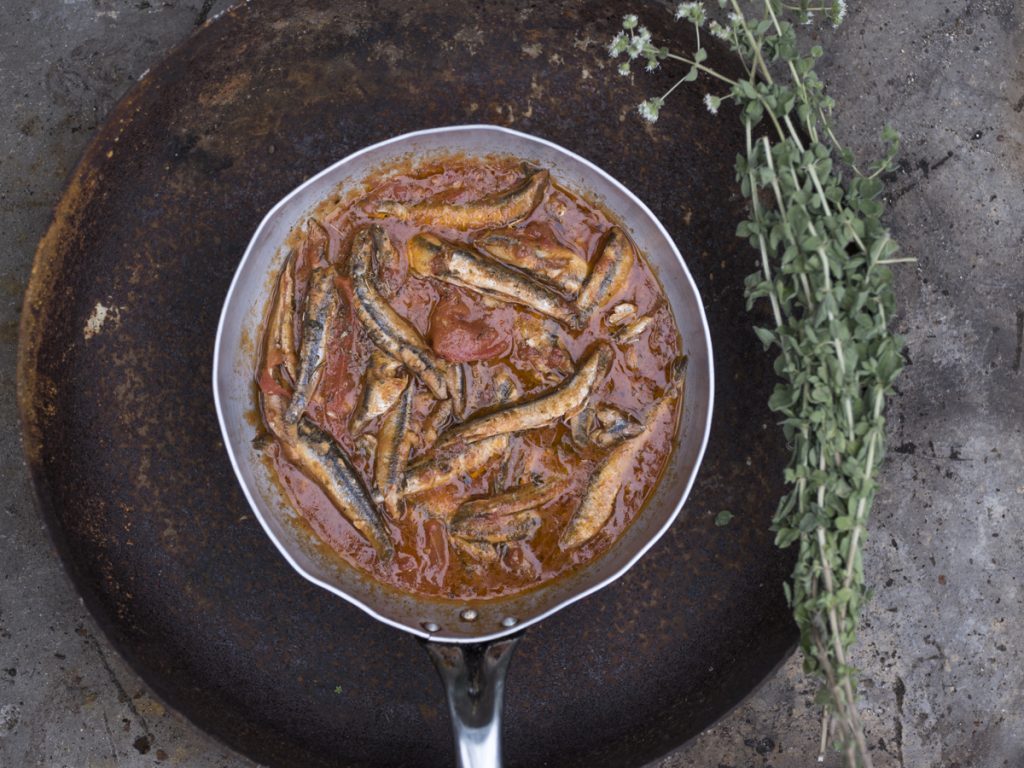
Cephalonian meat pie, eggplant in tomato sauce, fried cod served with aliada (garlicky mash potatoes) and bourgeto (whitebait in tomato sauce) are just some of Angela’s specialties, while Panos is a certified sommelier, serving the very best local wines from an extensive wine list.
Fried cod with aliada (garlicky mashed potatoes)
Serves 4
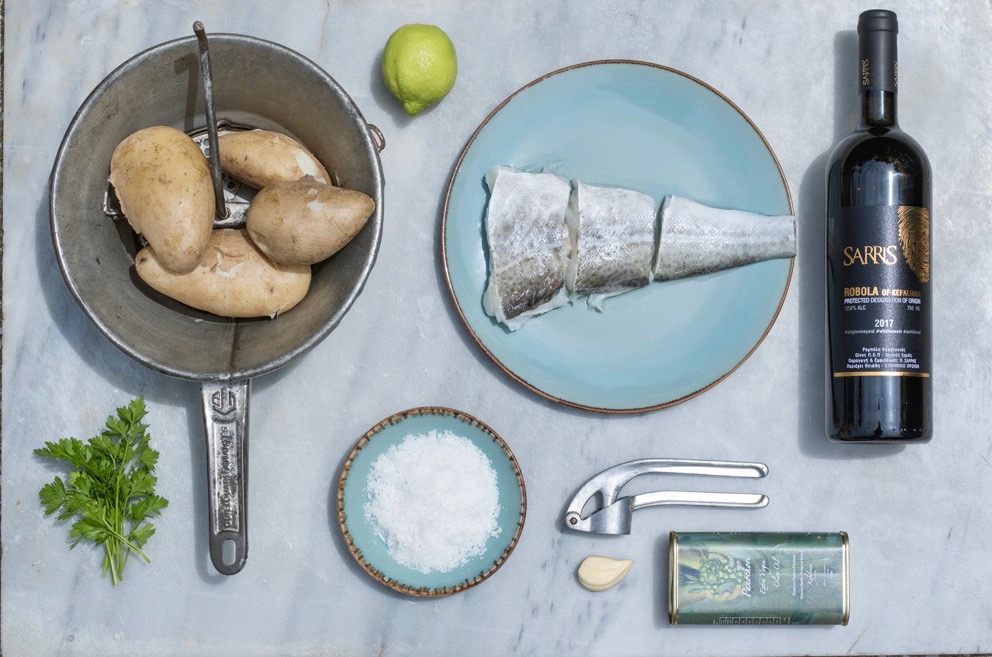
Ingredients
1 large piece of salted cod (soaked in water overnight, with a change of water 3 or 4 times to remove salt) • Vegetable oil for frying • For the batter: 230ml water • 170g flour • For the aliada: 1kg potatoes • 6 cloves of garlic • Juice from a whole lemon • 1 tablespoon salt
Preparation
Without peeling, wash the potatoes and boil well. Cut a piece from the end of the cod (about 1/3 of the filet) and simmer for 15 minutes. Reserve the water. Peel the potatoes while still warm and put in a mixer with garlic, lemon juice and one glass of the water used to boil the cod. Mix until creamy. In a deep plate, mix the water and flour to make the batter. Cut the remaining cod into pieces and dip them in the batter. Fry in a non-stick frying pan with plenty of oil. Serve the cod with the aliada and boiled beetroots.
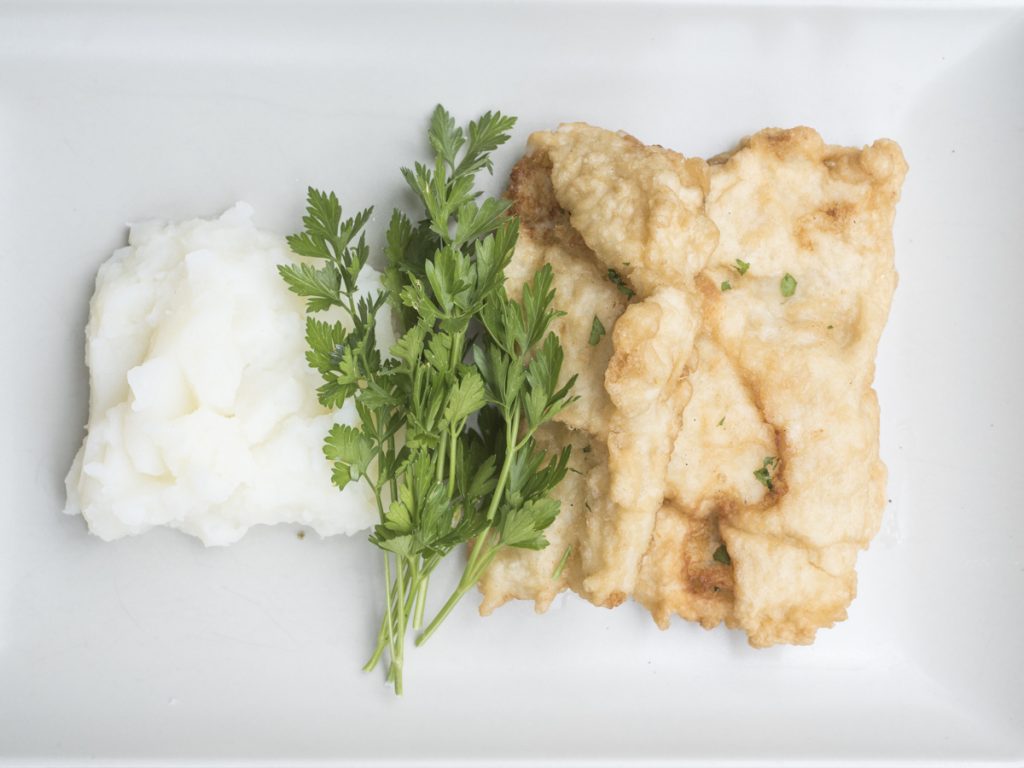
Wine Pairing
Robola is a wine intended to accompany fish, seafood, and “oily” summer dishes with light sauces. Of course, if you’d like to be faithful to the customs of Cephalonia, you’ll drink your Robola with the traditional dish of the island, fried cod with aliada.
Sarris, Robola of Kefalonia, 2017: From the “Megali Petra Domaine” of Panos Sarris comes this Robola, made with grapes from three privately owned vineyards on the southern slopes of Ainos. Stony and limestone soils on steep slopes that enjoy the sea breeze create the ideal conditions for the best expression of the variety. This wine has concentrated aromas of white flesh fruits, flowers and herbs, and a rich body, crisp acidity and a long aftertaste with notes of minerality.
― Panos Sarris, Sommelier
